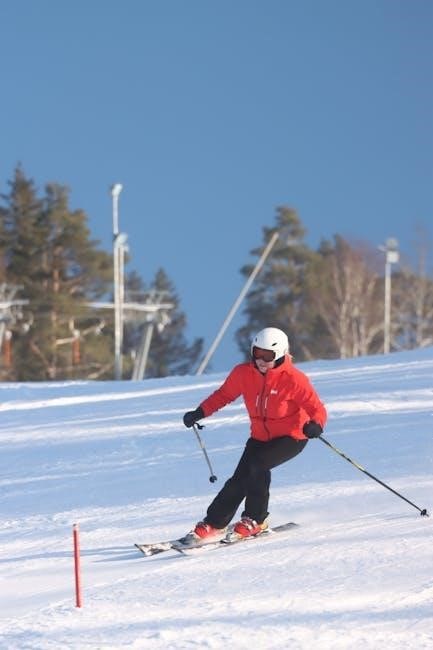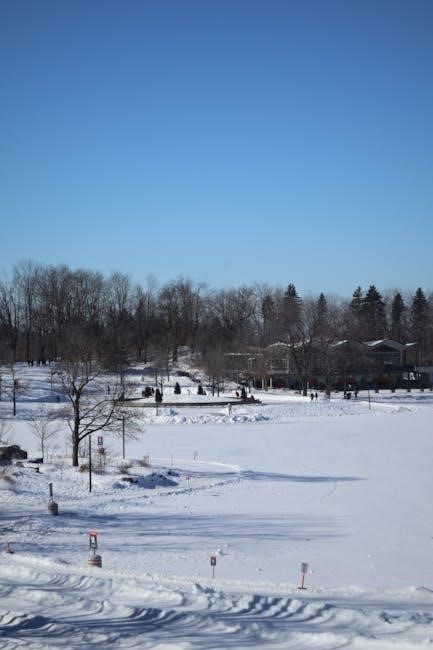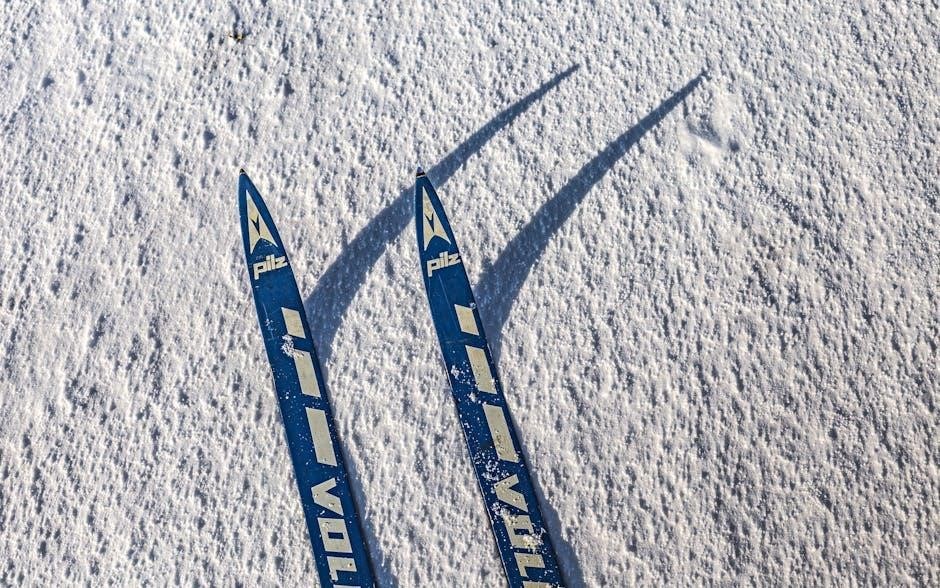Selecting the right cross-country ski length is crucial for optimal performance and enjoyment. Ski length varies by style, weight, and height, ensuring proper glide and efficiency.
Why Ski Length Matters for Performance
Ski length directly impacts performance in cross-country skiing by affecting glide, efficiency, and control. Longer skis provide better glide on flat terrain, while shorter skis enhance maneuverability in tight spaces. Proper length ensures optimal energy use, as overly long skis can be cumbersome, while too-short skis may reduce glide. Weight, height, and skiing style are key factors in determining the ideal length. For classic skiing, longer skis support traditional strides, while skate skiing requires shorter lengths for agility. Backcountry skis are longer for stability in deep snow. Balancing these elements ensures a skier can maintain rhythm, power, and comfort, maximizing overall performance.
How to Choose the Right Ski Length for Your Needs
Choosing the right cross-country ski length involves considering your weight, height, skiing style, and terrain. For classic skiing, skis are typically 15-20 cm longer than your height, enhancing glide. Skate skis are shorter, usually reaching between your chin and the top of your head, allowing agility. Backcountry skis are the longest, often 15-25 cm longer than your height, for stability in deep snow. Manufacturers provide size charts based on weight and style. Consider your skill level and objectives: longer skis suit experienced skiers seeking speed, while shorter ones are better for maneuverability. Adjustments may be needed based on specific ski flex and personal preference.

Factors Influencing Cross-Country Ski Length
Weight, height, skiing style, and ski flex are key factors in determining the ideal ski length, ensuring proper performance and comfort for different skiing techniques and terrains.
Weight as the Primary Determinant
In cross-country skiing, weight plays a crucial role in determining ski length, unlike alpine skiing where height is often the primary factor. Skiers weighing more require longer skis to maintain proper floatation and glide, while lighter individuals benefit from shorter skis for easier maneuverability. Manufacturers typically provide size charts based on weight ranges, ensuring the skis flex appropriately under the skier’s load. This weight-based approach helps optimize performance, as it directly impacts the ski’s ability to glide efficiently and provide the necessary support. Proper ski length ensures a balanced and enjoyable skiing experience.
Height and Skiing Style Considerations
While weight is the primary factor, height and skiing style also influence ski length. Classic cross-country skis are generally 15-20 cm longer than a skier’s height, promoting glide on groomed trails. Skate skis, shorter by 5-10 cm, enhance agility and speed. Backcountry skis, often longer, provide stability in deep snow. Skiing style—whether for racing, touring, or casual use—further tailors length choices. Taller skiers may prefer longer skis for stability, while shorter skiers might opt for shorter ones for easier handling. Balancing height and style ensures optimal performance and comfort, making each skiing experience more enjoyable and efficient.
Flex and Ski Characteristics
Flex and ski characteristics play a significant role in determining the ideal ski length. Softer flex skis are better for lighter skiers, offering improved grip, while stiffer skis suit heavier skiers for stability at higher speeds. Ski camber and sidecut also influence performance. Classic skis typically have more pronounced camber for efficient kick and glide, while skate skis feature a more subtle camber for speed and agility. Backcountry skis often have a wider sidecut for better flotation in deep snow. Balancing flex and camber ensures skis perform optimally, complementing weight and skiing style to enhance overall cross-country skiing experiences.

Popular Cross-Country Skiing Styles and Their Length Requirements
Classic, Skate, and Backcountry XC are the main styles, each requiring specific ski lengths. Classic skis are longest for glide, Skate skis shorter for agility, and Backcountry skis longest for stability.
Classic Cross-Country Skiing: Length and Features
Classic cross-country skis are designed for efficiency on groomed trails, typically measuring 15-20 cm longer than the skier’s height. Weight plays a significant role, with size charts often based on this factor. The skis feature a pronounced camber for better grip and glide, with a longer length enhancing stability and glide efficiency. Flex is critical, as stiffer skis perform better for experienced skiers, while softer options suit lighter individuals. Longer skis provide superior glide and tracking, making them ideal for endurance and touring. Proper ski length ensures optimal performance, balancing glide, comfort, and control for a seamless classic cross-country experience.
Skate Skiing: Optimal Length for Speed and Agility
Skate skiing prioritizes speed and agility, requiring shorter skis than classic styles. Optimal lengths typically range from 5-10 cm longer than the skier’s height. This shorter length allows for quick, dynamic movements and efficient power transfer during the skating technique. Weight plays a key role, with manufacturers providing size charts to match skier weight to ski length. Stiffness is crucial for performance, with stiffer skis offering better stability at higher speeds. Skate skis also feature a shorter camber, enabling rapid edge-to-edge transitions. Proper ski length ensures maximum speed, agility, and control, making them ideal for competitive and advanced skiers seeking high-performance results on groomed trails.
Backcountry XC Skiing: Longer Lengths for Stability
Backcountry XC skis are designed for stability and control in ungroomed terrain, requiring longer lengths to provide buoyancy and ease of use in deep snow. Skiers typically opt for skis 15-25 cm longer than their height, ensuring better flotation and reduced effort. These skis feature a wider design and softer flex to handle varied snow conditions, from powder to crust. The added length enhances stability on uneven surfaces, while the wider profile improves floatation. This makes them ideal for exploring remote areas, where durability and reliability are essential. Longer skis also reduce the risk of sinking, allowing skiers to glide effortlessly through challenging backcountry landscapes.
Size Charts and Formulas for Ski Length
Size charts and formulas guide ski length selection, with classic skis at height +20cm, skate skis shorter, and backcountry skis longer for stability. Use manufacturer charts based on weight for accuracy.
Using Height and Weight to Determine Ski Length
Determining the right ski length involves balancing height and weight. For classic skiing, skis are typically 15-20 cm longer than your height, while skate skis are shorter, around 5-10 cm above your height. Backcountry skis are longer for stability. Use the formula: height in inches × 2.6, then adjust by +15 for classic or +5 for skate. Weight plays a crucial role, with manufacturer charts providing precise recommendations. While height gives a starting point, weight ensures the ski flexes properly for optimal performance. Always consult manufacturer size charts for accurate fitting based on your weight and skiing style.
Manufacturer-Recommended Size Charts
Manufacturer size charts are essential for precise ski fitting. These charts typically use weight and height to determine the ideal ski length, ensuring proper flex and performance. For classic skis, they often recommend lengths 15–20 cm longer than your height, while skate skis are shorter, around 5–10 cm above. Backcountry skis are longer for stability. Each brand may vary, so it’s crucial to follow specific guidelines. Always refer to the manufacturer’s chart for your chosen style, as they tailor recommendations to their ski designs. This ensures optimal glide, efficiency, and enjoyment on the trails. Proper fitting enhances both performance and comfort.

Competitive Ski Lengths for Racing
Racing skis are longer for maximum speed and glide. Classic race skis range from 207-210 cm, while skate skis are 192-200 cm, optimizing performance for elite athletes.
Length Ranges for Maximum Speed and Glide
For competitive cross-country skiing, ski lengths are optimized to enhance speed and glide. Classic race skis typically range from 207 to 210 cm, providing a larger surface area for efficient glide on groomed trails. Skate skis, designed for agility and power, are shorter, ranging from 192 to 200 cm. These lengths allow racers to maintain rhythm and momentum, crucial for maximizing performance in high-speed events. Proper ski length ensures optimal energy transfer and minimal resistance, enabling athletes to maintain top speeds during races. Longer skis also offer better stability at higher velocities, making them ideal for professional competitors seeking every advantage.

Maintaining the Right Ski Length Over Time
Regularly assess your ski length as skills evolve, ensuring optimal performance and comfort. Adjustments may be needed for technique improvements or changes in skiing style over time.
Adjusting Ski Length Based on Skill Level and Use
As skill levels improve, skiers may need to adjust their ski length for better performance. Beginners often benefit from shorter skis for easier control, while advanced skiers prefer longer skis for increased glide and speed. Racing skiers typically opt for skis at the upper end of their size range to maximize efficiency. For backcountry skiing, longer skis provide stability and flotation in deep snow. Adjustments should also consider the specific terrain and technique, ensuring the skis match the intended use. Regularly reassessing ski length helps maintain optimal performance and comfort as skills evolve and skiing styles change over time.
Finding the perfect cross-country ski length is a blend of understanding your weight, height, skiing style, and personal preferences. By considering these factors and consulting size charts, you can optimize performance and enjoyment. Whether you’re gliding on groomed trails or exploring backcountry terrain, the right ski length ensures efficiency and comfort. Remember, ski length may need adjustments as your skills and skiing goals evolve. Invest time in selecting the ideal skis, and you’ll enhance your cross-country skiing experience, making every stride more enjoyable and effective on the snow.
